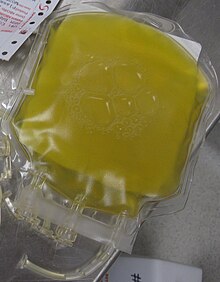
Back Bloedplasma Afrikaans بلازما الدم Arabic لپلازما (فيزيولوجيا) ARY بلازما ARZ Плазма крыві Byelorussian Кръвна плазма Bulgarian রক্তরস Bengali/Bangla Krvna plazma BS Plasma sanguini Catalan پلازمای خوێن CKB

Blood plasma is the yellow liquid part of blood. In normal blood, the blood cells are suspended in the plasma.
Plasma makes up about 55% of the total blood volume. It is mostly water (90% by volume) and contains dissolved proteins, glucose, clotting factors, mineral ions, hormones and carbon dioxide. Plasma is the transport medium for excretion.
In hospitals, blood plasma is prepared like this for blood transfusion. An anti-coagulant stops the blood clotting. Then tubes of blood are spun very fast in a centrifuge. The blood cells go to the bottom of the tubes. The plasma is poured into another container.[1]
Hospitals may give patients:
- Saline solution (pure water plus salt) for blood volume. This can be done quickly in an emergency.
- Blood plasma.
- Packed red cells.
- Whole blood.
Blood serum is blood plasma without fibrinogen or the other clotting factors (that is, whole blood minus both the cells and the clotting factors).[1]
Plasmapheresis is a medical therapy which involves taking out blood plasma, treating it, and putting it back in the patient.
- ↑ 1.0 1.1 Maton, Anthea; et al. (1993). Human biology and health. Englewood Cliffs N.J.: Prentice Hall. ISBN 0-13-981176-1.